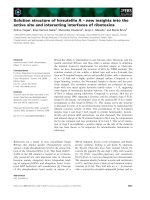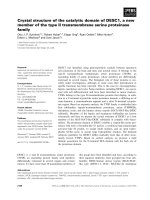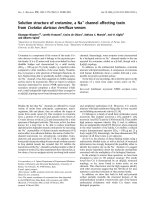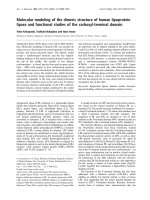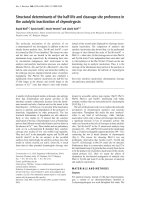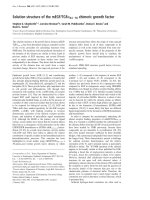Báo cáo Y học: Solution structure of the Alzheimer amyloid b-peptide (1–42) in an apolar microenvironment Similarity with a virus fusion domain potx
Bạn đang xem bản rút gọn của tài liệu. Xem và tải ngay bản đầy đủ của tài liệu tại đây (255.56 KB, 7 trang )
Solution structure of the Alzheimer amyloid b-peptide (1–42) in
an apolar microenvironment
Similarity with a virus fusion domain
Orlando Crescenzi
1
, Simona Tomaselli
1
, Remo Guerrini
2
, Severo Salvadori
2
, Anna M. D’Ursi
3
,
Piero Andrea Temussi
1
and Delia Picone
1
1
Dipartimento di Chimica, Universita
`
degli Studi di Napoli ‘Federico II’, Italy;
2
Dipartimento di Scienze Farmaceutiche, Universita
`
di
Ferrara, Italy;
3
Dipartimento di Scienze Farmaceutiche, Universita
`
di Salerno, Italy
The major components of neuritic plaques found in
Alzheimer disease (AD) are peptides known as amyloid
b-peptides (Ab), which derive from the proteolitic cleavage
of the amyloid precursor proteins. In vitro Ab may undergo a
conformational transition from a soluble form to aggrega-
ted, fibrillary b-sheet structures, which seem to be neuro-
toxic. Alternatively, it has been suggested that an a-helical
form can be involved in a process of membrane poration,
which would then trigger cellular death.
Conformational studies on these peptides in aqueous
solution are complicated by their tendency to aggregate,
and only recently NMR structures of Ab-(1–40) and
Ab-(1–42) have been determined in aqueous trifluoroeth-
anol or in SDS micelles. All these studies hint to the
presence of two helical regions, connected through a flex-
ible kink, but it proved difficult to determine the length
and position of the helical stretches with accuracy and,
most of all, to ascertain whether the kink region has a
preferred conformation. In the search for a medium which
could allow a more accurate structure determination, we
performed an exhaustive solvent scan that showed a high
propensity of Ab-(1–42) to adopt helical conformations in
aqueous solutions of fluorinated alcohols. The 3D NMR
structure of Ab-(1–42) shows two helical regions encom-
passing residues 8–25 and 28–38, connected by a regular
type I b-turn. The surprising similarity of this structure, as
well as the sequence of the C-terminal moiety, with those
of the fusion domain of influenza hemagglutinin suggests a
direct mechanism of neurotoxicity.
Keywords: Alzheimer disease; amyloid peptides; conforma-
tional analysis; fusion domain; NMR.
Alzheimer disease (AD), the well known neurodegenerative
disorder associated with neuronal loss, is at present one of
the most studied pathologies; nevertheless, it is still one of
the least understood at the molecular level.
The brains of AD patients are characterized by extracel-
lular proteic plaques and intracellular neurofibrillary tangles
[1]. Plaques are built up by fibrils whose major component
are peptides known as b-amyloid (Ab), which range in
length from 39 to 43 amino acids. All of them have a great
propensity towards aggregation in aqueous solution, but the
major form found in plaques is Ab-(1–42). The relative
abundance of Ab-(1–42) with respect to Ab-(1–40) reflects
the fact that even a small elongation of the stretch of
hydrophobic residues in the C-terminal region increases
dramatically the tendency of this peptide to aggregate [2].
Amyloid peptides originate from cleavage of a common
precursor called amyloid precursor protein (APP) [3], a
glycoprotein of 695–770 amino acids which comprises three
parts: the extracellular N-terminal region, a single hydro-
phobic transmembrane region and the cytoplasmic
C-terminal domain. As the genes encoding APP are on
chromosome 21, individuals affected by Down’s syndrome
overexpress APP and may develop early AD forms [4].
APP can be cleaved proteolitically by different proteases,
called a, b and c secretases [5]. The a secretase cleaves APP
within the Ab sequence, and its products are not neurotoxic.
Alternatively, APP can be hydrolyzed by the b secretase
activity at the N-terminus of Ab, which is successively
released by the c secretase after cleavage within the
membrane [6] either between residues 40 and 41 or between
residues 42 and 43. Thus, the N-terminal region of Ab-
(1–42) derives from the extracellular domain of the
precursor, whereas its C-terminal region derives from the
membrane-spanning domain [7].
It is generally recognized that the presence of fibrils is
necessary for toxicity [8] but it is not generally agreed
whether toxicity is generically linked to the occupation of a
large area of the cell surface or there is a direct action upon
the cell membrane. A possible explanation of the peptide
neurotoxicity invokes, as the key event, a membrane-
poration process. According to this view, which is supported
by the results of in vitro electrophysiologic measurements,
the a-helical conformation of the peptide would induce
formation of membrane channels, allowing the penetration
Correspondence to D. Picone, Dipartimento di Chimica, Universita
`
degli Studi di Napoli ÔFederico IIÕ, via Cintia 26, Complesso
Universitario di Monte S. Angelo, 80126 Napoli, Italy.
Fax: + 39 081 674409, Tel.: + 39 081 674406,
E-mail:
Abbreviations: AD, Alzheimer disease; Ab, amyloid beta-peptides;
Ab-(1–40), amyloid beta-peptide 1–40; Ab-(1–42), amyloid beta-
peptide 1–42; APP, amyloid precursor protein; HA_fd, fusion domain
of influenza hemagglutinin; HFIP, hexafluoroisopropanol.
(Received 18 July 2002, revised 16 September 2002,
accepted 19 September 2002)
Eur. J. Biochem. 269, 5642–5648 (2002) Ó FEBS 2002 doi:10.1046/j.1432-1033.2002.03271.x
of substances (such as metal ions) which can cause neuronal
death [9,10]. At any rate, both views evidence a critical role
for in vivo conformational transitions involving soluble
forms of the peptide. As a matter of fact, previous solution
studies evidenced that Ab can indeed assume different
conformations even in vitro, depending on the experimental
conditions. Thus, for example, it has been recently reported
that the fibrillogenesis process of Ab-(1–40) and Ab-(1–42)
involves an oligomeric a-helical intermediate [11].
Several NMR measurements on both Ab-(1–40) and
Ab-(1–42) have been carried out in different solvents
mimicking the interface between aqueous and apolar
phases, such as SDS micelles [12,13] and in solvents that
can reproduce an apolar microenvironment, such as
trifluoroethanol/water mixtures [14].
All these studies evidenced the presence of two helical
regions, connected by a more flexible and disordered link;
however, there is no consensus on the length and position of
the helical stretches nor on the structural features of the link
region. Another point that should be considered is the
complex heterogeneous nature of SDS solutions, which
does not necessarily reflect the conformational tendencies in
a physiological apolar environment (such as the lipid phase
of membranes). Moreover, the very role played by the
micellar environment is not generally agreed on: thus, Coles
et al. [12] suggested that the a-helical region might corres-
pond to the portion of the peptide crossing the membrane,
whereas Shao et al. [13] reported evidence that the peptide is
located entirely on the outside of the micelles, in contact
with the negatively charged surface.
In this paper we report on a CD and 2D NMR
conformational study of Ab-(1–42) in several media that
can create apolar microenvironments mimicking the lipid
phase of membranes. The most detailed structure was
obtained using aqueous mixtures of a fluorinated alcohol,
hexafluoroisopropanol (HFIP). HFIP has been chosen as a
result of a vast exploratory search because it can dissolve
Ab-(1–42) better than all other media and, at the same time,
it has a helix-promoting ability very similar to that of
trifluoroethanol [15,16].
MATERIALS AND METHODS
Solid phase peptide synthesis and purification
Ab-(1–42) was synthesized according to published methods
using standard solid-phase synthesis techniques [17] with a
Milligen 9050 synthesizer. Protected amino acids and
chemicals were purchased from Bachem, Novabiochem or
Fluka (Switzerland). The resin (4-hydroxymethylphenoxy-
acetic acid) on the polyethyleneglycol/polystyrene support,
loaded with N
a
-Fmoc-Ala (Fmoc-Ala-PAC-PEG-PS) was
from Millipore (Waltham, MA, USA). Fmoc-Ala-PAC-
PEG-PS resin (0.15 mmolÆg
)1
, 1 g) was treated with piperi-
dine (20%) in dimethylformamide and linked with
N
a
-Fmoc-Ile (eightfold excess), via its pentafluorophenyl
active ester. All the other N
a
-Fmoc amino acids penta-
fluorophenyl active ester were sequentially coupled to the
growing peptide chain and the coupling reaction time was
1 h. To optimize the synthesis, after each acylation step, we
adopted a capping protocol with N-(2-chlorobenzyloxycar-
bonyloxy) succinimide as described [18]. Piperidine (20%) in
dimethylformamide was used to remove the Fmoc group at
all steps. After deprotection of the last N
a
-Fmoc group, the
peptide resin was washed with methanol and dried in vacuo
to yield the protected Ab-(1–42)-PAC-PEG-PS-Resin.
The protected peptide-resin was treated with trifluoroacetic
acid/H
2
O/phenol/ethanedithiol/thioanisole (reagent K)
(82.5 : 5 : 5 : 2.5 : 5, v/v/v/v) 10 mL per 1 g of resin at
room temperature for 3 h [19]. After filtration of the
exhausted resin, the solvent was concentrated in vacuo and
the residue triturated with ether. The crude peptide was
purified by high performance liquid chromatography using
a Polymer Laboratories PLRP-S polymer-based reversed-
phase column. The column was maintained at 45 °Cand
perfused at a flow rate of 1 mLÆmin
)1
with a mobile phase
containing solvent A (5 m
M
ammonium acetate, pH 8 in 5%
acetonitrile), and a linear gradient from 0 to 20% of solvent
B(5m
M
ammonium acetate, pH 8 in 90% acetonitrile) in
25 min was adopted for the elution of the peptide. The
fraction containing the pure peptide was lyophilized twice
and the purity assessed by a MALDI-TOF analysis using a
Hewlett Packard G2025A LD-TOF system mass spectro-
meter and a-cyano-4-hydroxycinnamic acid as matrix.
Sample preparation
It has been shown that a trifluoroacetic acid pretreatment
renders Ab easily soluble in aqueous solutions and in
organic solvents; the trifluoroacetic acid treated Ab exhibits
the properties of monomeric, random coil structures and
lacks preaggregated material [20]. Thus, in order to ensure
sample reproducibility and removal of aggregated states
which can be present, dry peptide was pretreated with neat
trifluoroacetic acid for 3 h, followed by 10-fold dilution with
milliQ water and lyophilization. This procedure was adop-
ted for all CD and NMR samples immediately before
dissolution in the appropriate solvent.
Circular dichroism spectroscopy
Circular dichroism (CD) measurements were performed on
a JASCO J-715 spectropolarimeter equipped with a ther-
mostated cell holder, using a quartz cell of 1.0-mm path
length. Spectra were collected over the wavelength range
260–190 nm with a bandwidth of 2.0 nm and a time
constant of 8.0 s, and corrected for the contribution of the
buffer. In order to prevent peptide aggregation, which tends
to occur when water is added directly, a prescored amount
of trifluoroacetic acid-treated peptide was dissolved in
120 lL of HFIP and 160 lL of an appropriate HFIP/water
mixture were added cautiously, to give a final peptide
concentration of approximately 80 l
M
and a water content
between 0 and 50% by volume. Unless otherwise stated, the
temperature was 25 °C.
For estimation of secondary structure content, CD
spectra were analyzed by a linear combination fit using
the reference data of Greenfield and Fasman [21].
NMR spectroscopy
Samples for NMR spectroscopy were prepared by dissol-
ving approximately 4 mg of trifluoroacetic acid-treated
peptide in 200 lLofd
2
-HFIP, followed by dilution
with 300 lLofd
2
-HFIP/H
2
O(ord
2
-HFIP/D
2
O), 2 : 1
v/v. This results in a final HFIP/water ratio of 80 : 20 v/v,
Ó FEBS 2002 Solution structure of Ab-peptide (1–42) (Eur. J. Biochem. 269) 5643
corresponding to a water molar fraction of 0.60. The actual
peptide concentration (approximately 2 m
M
)waschecked
before and after each measurement by UV absorbance,
using an estimated extinction coefficient of 1280
M
)1
Æcm
)1
at 280 nm.
NMR spectra were recorded on a Bruker DRX-600
spectrometer. One-dimensional spectra were recorded in the
Fourier mode with quadrature detection and the water
signal was suppressed by low-power selective irradiation.
Two-dimensional COSY [22], TOCSY [23] and NOESY
[24] experiments were collected in the phase-sensitive mode
using quadrature detection in x
1
by time-proportional
phase increase of the initial pulse [25]. Typical data sizes
were 2048 addresses in t
2
and 512 equidistant t
1
values. A
mixing time of 80 ms was used for the TOCSY experiments.
NOESY experiments were run at 300 K with mixing times
in the range of 80–200 ms. The data were transformed with
NMRPIPE
[26] and analyzed with
NMRVIEW
[27]. Before
Fourier transformation, the time domain data were multi-
plied by shifted sine functions (COSY) or lorentz-to-gauss
windows (NOESY, TOCSY) in the direct dimension, and
by shifted sine or sine square functions in the indirect
dimension. The chemical shifts were referenced to the
residual HFIP signal at 3.88 p.p.m.
The assignment of chemical shifts was obtained by the
usual approach described by Wu
¨
thrich [28], examining
COSY, TOCSY and NOESY spectra; some ambiguities
arising from signal overlaps were resolved by examining
spectra acquired at different temperatures (290 and 310 K)
or in a d
2
-HFIP/D
2
O mixture. The assignment of chemical
shifts was brought to 87% completeness (100% complete
for the backbone). NOE cross peaks (d
2
-HFIP/H
2
Oand
d
2
-HFIP/D
2
O spectra) were integrated with NMRView and
were converted into upper distance bounds with the routine
CALIBA of the program package DYANA [29]. After
discarding redundant and duplicated constraints, the final
list included 130 intraresidue and 283 interresidue (149
sequential and 134 medium range) constraints, which were
used to generate an ensemble of 100 structures by the
standard protocol of simulated annealing in torsion angle
space implemented in DYANA (using 6000 steps). No
dihedral angle restraints and no hydrogen bond restraints
were applied. The best 20 structures, which had low values
of the target functions (0.83–1.19
A
˚
2
) and small residual
violations (maximum violation ¼ 0.38 A
˚
), were refined by
in vacuo minimization in the AMBER 1991 force field [30],
using the program
SANDER
of the AMBER 6 suite [31]. To
mimic the effect of solvent screening, all net charges were
reduced to 20% of their real value, and moreover a distance-
dependent dielectric constant (e ¼ r) was used. The cut-off
for non–bonded interactions was 12 A
˚
. At this stage, the
protonation states of the amino acid side chains were chosen
to correspond to a low pH value, on account of the fact
that the peptide samples had been pretreated with trifluoro-
acetic acid (see above). The NMR-derived upper bounds
were imposed as semiparabolic penalty functions, with force
constants of 16 kcalÆmol
)1
ÆA
˚
2
; the function was shifted to
linear when the violation exceeded 0.5 A
˚
.Thebest10
structures after minimization had AMBER energies ranging
from )441.4 to )391.1 kcalÆmol
)1
, and were used to
represent the structure of Ab-(1–42).
The final structures were analyzed using the program
MOLMOL
[32].
RESULTS
In the search for conditions which allow structural studies of
Ab in a homogeneous, isotropic environment, we have
examined the solubility and spectroscopic features of
Ab-(1–42) in a variety of media in different concentration
and temperature conditions. Several organic solvents and
mixtures of organic solvents with water, such as trifluoro-
ethanol, trifluoroethanol/H
2
O, hexafluoroacetone hydrate,
hexafluoroacetone hydrate/H
2
O, HFIP/H
2
O, CH
3
OH,
dimethylsulfoxide, dimethylsulfoxide/H
2
O, were tested.
The solubility of Ab-(1–42) in methanol is poor; in contrast,
trifluoroethanol and mixtures of trifluoroethanol/H
2
Oare
able to dissolve the peptide but after few hours a precipitate
was observed. Hexafluoroacetone hydrate and hexafluoro-
acetone hydrate/water mixtures can also dissolve the peptide
at millimolar concentrations, and the solutions were stable
for weeks; however, NMR signals were broad and the
quality of data acquired in these solvents didn’t allow an
easy interpretation. Dimethylsulfoxide and mixtures of
dimethylsulfoxide/H
2
O (containing up to 5% water) seemed
to be suitable solvents for studying the structure in solution
by NMR, thus an almost complete backbone assignment
was performed. However, the analysis of NOESY spectra
evidenced only the presence of sequential, short-range
contacts, suggesting the absence of any preferential confor-
mation.
In the end, we found that stable, m
M
solutions of Ab-
(1–42)canbepreparedinHFIP/H
2
O mixtures. Water
content and temperature can be changed within fairly large
ranges without peptide precipitation. HFIP was chosen in
view of its solvent power and also its ability to stabilize
helical structures. In fact, although HFIP is a polar
molecule, it can solvate apolar surfaces with its strongly
hydrophobic side chains; this feature has been aptly
described by Rajan et al. as a Teflon coating that can
surround a helix [16] in the case of a mixture of water and
hexafluoroacetone hydrate, a mixture with properties very
similar to those of aqueous mixtures of HFIP. CD
measurements on Ab-(1–42) have shown that in HFIP/H
2
O
mixtures, under optimal conditions, the helical content can
be higher than in other solvent mixtures in which conform-
ational studies have been reported, such as aqueous
trifluoroethanol or SDS micelles (data not shown).
The solvent mixture composition we adopted for NMR
was also optimized by CD. Figure 1 shows the molar
ellipticity at 220 nm, which can be related to the a-helix
content, as a function of water percentage in the mixture.
The ellipticity increases with the water concentration,
reaching a plateau at approximately 20% water. Corres-
pondingly, the helix content, as estimated by standard linear
combination fits of the spectra [21], increases from 54% in
neat HFIP to approximately 82% at the plateau. The CD
spectrum in the 80 : 20 mixture is essentially unchanged in
the temperature range 10–45 °C (data not shown), suggest-
ing a high conformational stability of Ab-(1–42) in this
solvent medium, which was then selected to perform a
detailed conformational analysis by 2D NMR. Further-
more, the Ab-(1–42) solution in aqueous HFIP was very
stable, as there was no evidence of aggregation or precipi-
tation and the NMR spectra did not change over several
weeks. The quality of NMR data is shown in Fig. 2, which
displays the low field region of a 600-MHz NOESY
5644 O. Crescenzi et al.(Eur. J. Biochem. 269) Ó FEBS 2002
spectrum acquired at 300 K with a mixing time of 150 ms.
The high number of NH–NH effects, summarized in Fig. 3,
is consistent with the prevalent helical fold suggested by the
CD data. At first sight, the NOE pattern could be
interpreted as a good evidence of the presence of a single
helical region encompassing residues 8–40. However,
whereas sequential and medium range connectivities expec-
ted for helical regions, i.e. HN–HN (i, i +1), Ha–HN
(i, i +3),Ha–Hb (i, i +3)andHa–HN (i, i +4),are
present (or hidden by trivial spectral overlaps) along the
whole stretch 8–40, the crucial contact between Ser26 Ha
and Ala30 HN is absent. Moreover, Ha–HN (i, i +1)
contacts, typical of extended structures, are also rather
strong in this region: taken together, these features can point
to an enhanced flexibility or possibly a break in the helix.
Structure calculation by a standard DYANA protocol
yielded a bundle of 20 structures with satisfactory values of
the target function; after restrained minimization in the
AMBER force field (Table 1), the best structures formed a
tightly clustered family, consisting of two helical regions
(residues 8–25 and 28–38, respectively), connected by a kink
(Fig. 4). The first helix is very well defined, with a backbone
RMSD of just 0.38 A
˚
, while the second helix is interrupted
in some structures at the level of the Ile32–Gly33 connec-
tion. Closer inspection of the kink region reveals the
presence of a type I b-turn centred on residues 25–26, while
residue 27 displays values of the backbone / e w dihedrals
around ()150°, 40°), i.e. in the Ôadditionally allowedÕ region
of the Ramachandran map. Unconstrained minimization of
the structures did not produce any major rearrangement in
this region, which instead would be expected if the observed
dihedrals were imposed by the influence of artifactual NMR
restraints. Thus, the type I b-turn centred on residues 25–26
Fig. 2. Low field region of a 600-MHz NOESY spectrum of Ab-(1–42)
in HFIP/water at 300 K. The mixing time was 150 ms.
Fig. 3. Bar diagram showing the NOE con-
nectivities observed for Ab-(1–42) in HFIP/
water 80 : 20 at 300 K. The thickness of lines is
related to the strength of connectivities.
Fig. 1. Molar ellipticity at 220 nm of Ab-(1–42) in HFIP/water
mixtures as a function of water percentage at 25 °C.
Table 1. Summary of residual constraint violations and energies. The
force constants for the distance constraints were 16 kcalÆmol
)1
ÆA
˚
)2
.
The errors are given as ± SD.
Range, d (A
˚
)
Average number of
distance constraint violations
0.1 < d < ¼ 0.2 26.9 ± 4.1
0.2 < d < ¼ 0.3 9.7 ± 2.2
0.3 < d < ¼ 0.4 1.6 ± 1.1
0.4 < d < ¼ 0.5 0.7 ± 0.4
0.5 < d 0
Average maximum violation (A
˚
) 0.43 ± 0.03
Energy term
Average AMBER
energies (kcalÆmol
)1
)
E (AMBER) )415.7 ± 16.4
E (distance constraint) 25.5 ± 2.0
E (Van der Waals) )159.6 ± 4.5
E (total) )390.1 ± 17.6
Ó FEBS 2002 Solution structure of Ab-peptide (1–42) (Eur. J. Biochem. 269) 5645
appears to be a genuine feature of the global structure of
Ab-(1–42).
At first sight, the shape of the molecule resulting from our
structure determination is similar to other helical structures
of full length Ab, i.e. Ab-(1–40) or Ab-(1–42) [12–14]:
however, a more detailed comparison reveals a number of
significant differences. The structure of Ab-(1–40) in
trifluoroethanol/water mixture [14] displays two helices,
over residues 15–22 and 30–35, separated by a 6-residues
long disordered region. The remaining NMR studies on full
length Ab published to date have been carried out in SDS
micelles. The structure of Ab-(1–40) reported by Coles et al.
[12] consists of a single helix from residue 15–36, with only a
slight bend around residues 26–27; by contrast, the structure
published by Shao et al.[13]isdescribedintermsoftwo
a-helices, 10–24 and 28–42, separated by a marked loop
involving residues 25–27, with no significant difference
found between Ab-(1–40) and Ab-(1–42). Thus, even in
comparison with these SDS studies, the helical regions in
our structure are longer and better defined; moreover, while
an a-helix break is present more or less at the same position
in all previous cases, we observe a well defined elbow-shaped
structural element.
We believe that the regularity of our structure in
comparison to those described in [12–14] is a direct
consequence of an environment, which can simulate in
some way the inner membrane, i.e. the lipid phase.
DISCUSSION
Conformational studies in aqueous solution of Ab have
been hampered by fast peptide aggregation, and only very
recently some NMR investigation on small fragments
[33,34], as well as on Ab-(1–40)
ox
[35], containing methio-
nine sulfoxide at position 35, have been reported. All these
studies, although referred to fragments of different length,
with different oxidation states of Met35, and at different
pH, suggest that in aqueous solution the peptide can be
described as a random coil, with only a small population of
local nonrandom structures. Overall, these data indicate
that bulk water is not suitable for high resolution conform-
ational analysis of Ab. Moreover several structural inves-
tigations in different solvents, reviewed in [12], suggest that
in vitro the secondary structure of Ab is strongly dependent
on experimental conditions. This is a typical feature of small
and medium size peptides, but in the case of Ab the
conformational flexibility is particularly interesting, as it can
be related to its biological activity. The choice of the solvent
is crucial not only to overcome the solubility problem, but
also to try to simulate in some aspects the physico-chemical
Fig. 4. Bundle of the best 10 structures of Ab-(1–42) after AMBER
minimization, superimposed for: (A) backbone atoms of residues 8–38
(RMSD = 0.86 A
˚
); (B) backbone atoms of residues 8–25
(RMSD = 0.38 A
˚
); (C) backbone atoms of residues 26–27 (RMSD =
0.048 A
˚
); (D) backbone atoms of residues 28–38 (RMSD = 0.59 A
˚
).
Fig. 5. Stereo view of the lowest energy struc-
ture colored according to the electrostatic
potential.
5646 O. Crescenzi et al.(Eur. J. Biochem. 269) Ó FEBS 2002
features of the different environments to which the peptide
is exposed in vivo. In particular, if the peptide exerts its
toxicity by membrane disruption, it is important to check
whether Ab-(1–42) can assume a regular ordered confor-
mation in an environment with properties similar to those of
the lipid phase of the membrane, which promotes the
formation of short-range H-bonds inducing helical struc-
tures.
The structural characterization of a monomeric, soluble
form of Ab-(1–42) in isotropic media is necessary not only
to shed some light on the steps involved in the fibrillogen-
esis, but, most of all, to evaluate the role of Ab-(1–42) in the
interaction with the membrane.
The structure of Ab-(1–42) found in aqueous hexafluoro-
isopropanol, a medium that mimics the lipidic environment
of membranes, is boomerang-shaped. It is interesting to
note that the second helix (residues 28–38) corresponds to
the transmembrane region of APP, and has the typical
amino acid composition of transmembrane helices, i.e. small
(Gly and Ala) and hydrophobic (Ile, Leu, Met and Val)
residues [36]. The only charged residue along this sequence is
Lys28, i.e. at the N-terminal end of the helix.
A contact surface representation of the lowest energy
structure colour-coded according to the electrostatic poten-
tial (Fig. 5) shows the presence of a wide positive region
within the first helical region. Interestingly, if one positions
this surface facing the charged phospholipids of a mem-
brane, the relative orientation of the second helix is such
that it can insert into the membrane. It is interesting to note
that the structure we find for Ab-(1–42) is in very good
agreement with a theoretical model proposed for membrane
bound Ab-(1–40) [37]; indeed, between Lys16 and Val40 the
two structures are almost identical, including the turn
involving Gly25, Ser26 and Asn27. Different packing
schemes giving rise to membrane channels have been
proposed for this structure [37].
TheoverallshapeofAb-(1–42) is strongly reminiscent of
the structure of the fusion domain of influenza hemagglu-
tinin (HA_fd), recently determined in detergent micelles [38]
(Fig. 6A and B). Even more significant is the finding that
the sequences of the C-terminal part of Ab-(1–42) and that
of HA_fd share indeed a high similarity (Fig. 6C) dictated
essentially by the presence of similarly spaced glycine
residues, which are considered essential for a good insertion
into the membrane and are also frequently involved in
membrane protein dimerization [39]. The role of these
residues is also evidenced by a similar distribution on the
surface of the structures. The breaks in the helix-break-helix
motif (indicated by boxed residues), although at nearby
positions in the two sequences, are not coincident; however,
both structures feature a hydrophobic patch in the inner
region of the bent, made up by a cluster of 4/5 aliphatic and/
or aromatic side-chains. These findings lend strong support
to the hypothesis that the peptide neurotoxicity is due to a
membrane-poration process [10,11]. This view is also
confirmed by the very recent observation that in vitro
Ab-(1–40) can insert into a lipid bilayer just by its
C-terminus [40]; moreover, upon insertion a conformational
transition generating approximately 60% a-helix has been
evidenced. By contrast, it has been proposed that HA_fd
inserts both helical stretches into the membrane [38].
Accordingly, it is possible that the mechanism of membrane
interaction and destabilization is different in the case of Ab,
but it is fair to say that the similarity with the fusion domain
of a virus is strongly suggestive of membrane disruption.
The recent observation of a strong synergism between Ab
and several viruses at the stage of attachment or entry into
the cell lends further support to this hypothesis [41].
Coordinates
Coordinates have been deposited in the Protein Data Bank.
The access code is 1IYT.
ACKNOWLEDGMENTS
This work was supported by a grant from Regione Campania (legge
regionale 41/94), Italy.
REFERENCES
1. Iversen, L.L., Mortishire-Smith, R.J., Pollack, S.J. & Shearman,
M.S. (1995) The toxicity in vitro of beta-amyloid protein. Biochem.
J. 311, 1–16.
2. Jarrett, J.T., Berger, E.P. & Lansbury, P.T. Jr (1993) The C-ter-
minus of the beta protein is critical in amyloidogenesis. Ann. NY
Acad. Sci. 695, 144–148.
3. Selkoe, D.J. (1994) Normal and abnormal biology of the b-amy-
loid precursor protein. Annu. Rev. Neurosci. 17, 489–517.
4. Masters, C.L., Simms, G., Weinman, N.A., Multhaup, G.,
McDonald, B.L. & Beyreuther, K. (1985) Amyloid plaque core
protein in Alzheimer disease and Down syndrome. Proc. Natl
Acad.Sci.USA82, 4245–4249.
5. Esler, W.P. & Wolfe, M.S. (2001) A portrait of Alzheimer secre-
tases-new features and familiar faces. Science 293, 1449–1454.
6. Lichtenthaler, S.F., Beher, D., Grimm, H.S., Wang, R.,
Shearman, M.S., Masters, C.L. & Beyreuther, K. (2002) The
intramembrane cleavage site of the amyloid precursor protein
depends on the length of its transmembrane domain. Proc. Natl
Acad.Sci.USA99, 1365–1370.
Fig. 6. Comparison of the shapes of the lowest energy structure of
HA_fd (A) and of the 1–35 region of Ab-(1–42) (B). Residuesidechains
are colored according to their hydrophobic character (high ¼ red,
low ¼ blue). The sequences of the two peptides, aligned with
CLUSTALX
[42], are shown in panel (C). Identical residues are reported
in green, conserved or semiconserved in yellow.
Ó FEBS 2002 Solution structure of Ab-peptide (1–42) (Eur. J. Biochem. 269) 5647
7. Lichtenthaler, S.F., Wang, R., Grimm, H., Uljon, S.N., Masters,
C.L. & Beyreuther, K. (1999) Mechanism of the cleavage specifi-
city of Alzheimer’s disease gamma-secretase identified by phenyl-
alanine-scanning mutagenesis of the transmembrane domain of
the amyloid precursor protein. Proc.NatlAcad.Sci.USA96,
3053–3058.
8. Koo, E.H., Lansbury, P.T. & Kelly, J.W. (1999) Amyloid diseases:
abnormal protein aggregation in neurodegeneration. Proc. Natl
Acad. Sci. USA 96, 9989–9990.
9. Rhee, S.K., Quist, A.P. & Lal, R. (1998) Amyloid beta protein-
(1–42) forms calcium-permeable, Zn
2+
-sensitive channel. J. Biol.
Chem. 273, 13379–13382.
10. Lin, H., Bhatia, R. & Lal, R. (2001) Amyloid beta protein forms
ion channels: implications for Alzheimer’s disease pathophysiol-
ogy. FASEB J. 15, 2433–2444.
11. Kirkitadze, M.D., Condron, M.M. & Teplow, D.B. (2001) Iden-
tification and characterization of key kinetic intermediates in
amyloid b-protein fibrillogenesis. J. Mol. Biol. 312, 1103–1119.
12. Coles, M., Bicknell, W., Watson, A.A., Fairlie, D.P. & Craik, D.J.
(1998) Solution structure of amyloid b-peptide (1–40) in a water-
micelle environment. Is the membrane-spanning domain where we
think it is? Biochem. 37, 11064–11077.
13. Shao, H., Jao, S., Ma, K. & Zagorski, M.G. (1999) Solution
structures of micelle-bound amyloid b-(1–40) and b-(1–42) pep-
tides of Alzheimer’s disease. J. Mol. Biol. 285, 755–773.
14. Sticht, H., Bayer, P., Willbold, D., Dames, S., Hilbich, C.,
Beyreuther, K., Frank, R.W. & Rosch, P. (1995) Structure of
amyloid A4-(1–40) -peptide of Alzheimer’s disease. Eur. J. Bio-
chem. 233, 293–298.
15. Bhattacharjya, S., Venkatraman, J., Kumar, A. & Balaram, P.
(1999) Fluoroalcohols as structure modifiers in peptides and
proteins: hexafluoroacetone hydrate stabilizes a helical
conformation of melittin at low pH. J. Peptide Res. 54, 100–111.
16. Rajan, R., Awasthi, S.K., Bhattachajya, S. & Balaram, P. (1997)
ÔTeflon-coated peptidesÕ: hexafluoroacetone trihydrate as a struc-
ture stabilizer for peptides. Biopolymers 42, 125–128.
17. Atherton, E. & Sheppard, R.C. (1989) Solid Phase Peptide Syn-
thesis, (D. Rickwood & B.D. Hames, eds.) IRL Press, Oxford.
18. Ball, H.L. & Mascagni, P. (1996) Chemical synthesis and pur-
ification of proteins: a methodology. Int. J. Pept. Protein Res. 48,
31–47.
19. King, D.S., Fields, C.G. & Fields, G.B. (1990) A cleavage method
which minimizes side reactions following Fmoc solid phase pep-
tide synthesis. Int. J. Pept. Protein Res. 36, 255–266.
20. Jao, S.C., Ma, K., Talafous, J., Orlando, R. & Zagorski, M.G.
(1997) Trifluoroacetic acid pretreatment reproducibly disaggre-
gates the amyloid b-peptide. Int. J. Exp. Clin. Invest. 4, 240–252.
21. Greenfield, N. & Fasman, G.D. (1969) Computed circular
dichroism spectra for the evaluation of protein conformation.
Biochemistry 8, 4108–4116.
22. Aue, W.P., Bartholdi, E. & Ernst, R.R. (1976) Two-dimensional
spectroscopy. Application to nuclear magnetic resonance. J. Chem.
Phys. 64, 2229–2246.
23. Bax, A. & Davis, D.G. (1985) Practical aspect of two-dimensional
transverse NOE spectroscopy. J. Magn. Reson. 65, 335–360.
24. Jeener, J., Meyer, B.H., Bachman, P. & Ernst, R.R. (1979)
Investigation of exchange processes by two-dimensional NMR
spectroscopy. J. Chem. Phys. 71, 4546–4553.
25. Marion, D. & Wu
¨
thrich, K. (1983) Application of phase sensitive
two-dimensional correlated spectroscopy (COSY) for measure-
ments of
1
H-
1
H spin-spin coupling costants in proteins. Biochem.
Biophys. Res. Comm. 113, 967–971.
26. Delaglio, F., Grzesiek, S., Vuister, G., Zhu, G., Pfeifer, J. & Bax,
A. (1995) NMRPipe: a multidimensional spectral processing sys-
tem based on UNIX pipes. J. Biomol. NMR 6, 277–293.
27. Johnson, B.A. & Blevins, R.A. (1994) NMRView: a com-
puter program for the visualization and analysis of NMR data.
J. Biomol. NMR 4, 603–614.
28. Wu
¨
thrich, K. (1986) NMR of Proteins and Nucleic Acids, John
Wiley & Sons, New York.
29. Gu
¨
ntert, P., Mumenthaler, C. & Wu
¨
thrich, K. (1997) Torsion
angle dynamics for NMR structure calculation with the new
program DYANA. J. Mol. Biol. 273, 283–298.
30. Weiner, S.J., Kollman, P.A., Nguyen, D.T. & Case, D.A. (1986)
An all atom force field for simulations of proteins and nucleic
acids. J. Comp. Chem. 7, 230–252.
31. Pearlman, D.A., Case, D.A., Caldwell, J.W., Ross, W.S.,
Cheatham, T.E. III, DeBolt, S., Ferguson, D., Seibel, G. &
Kollman, P.A. (1995) AMBER, a package of computer programs
for applying molecular mechanics, normal mode analysis,
molecular dynamics and free energy calculations to simulate the
structural and energetic properties of molecules. Comp. Phys.
Commun. 91, 1–41.
32. Koradi, R., Billeter, M. & Wu
¨
thrich, K. (1996) MOLMOL: a
program for display and analysis of macromolecular structures.
J. Mol. Graph. 14, 51–55.
33. Jarvet, J., Damberg, P., Bodell, K., Eriksson, L.E.G. & Gra
¨
slund,
A. (2000) Reversible random coil to b-sheet transition and the
early stage of aggregation of the Ab (12–28) fragment from the
Alzheimer. J. Am. Chem. Soc. 122, 4261–4268.
34. Zhang, S., Iwata, K., Lachenmann, M.J., Peng, J.W., Li, S.,
Stimson, R.R., Lu, Y.A., Felix, A.M., Maggio, J.E. & Lee, J.P.
(2000) The Alzheimer’s peptide Ab adopts a collapsed coil struc-
ture in water. J. Struct. Biol. 130, 130–141.
35. Riek, R., Gu
¨
ntert, P., Do
¨
bell, H., Wipf, B. & Wu
¨
thrich, K. (2001)
NMR studies in aqueous solution fail to identify significant con-
formational differences between the monomeric forms of two
Alzheimer peptides with widely different plaque-competence, Ab
(1–40)
ox
and Ab (1–42)
ox
. Eur. J. Biochem. 268, 5930–5936.
36. Eilers, M., Shekar, S.C., Shieh, T., Smith, S.O. & Fleming, P.J.
(2000) Internal packing of helical membrane proteins. Proc. Natl
Acad. Sci. USA 97, 5796–5801.
37. Durell, S.R., Guy, R., Arispe, N., Rojas, E. & Pollard, B. (1994)
Theoretical models of the ion channel structure of amyloid
b-protein. Biophys. J. 67, 2137–2145.
38. Han, X., Bushweller, J.H., Cafiso, D.S. & Tamm, L.K. (2001)
Membrane structure and fusion-triggering conformational change
of the fusion domain from influenza hemagglutinin. Nat. Struct.
Biol. 8, 715–720.
39. Javadpour, M.M., Eilers, M., Groesbeek, M. & Smith, S.O. (1999)
Helix packing in polytopic membrane proteins: role of glycine in
transmembrane helix association. Biophys. J. 77, 1609–1618.
40. Ji, S.R., Wu, Y. & Sui, S. (2002) Cholesterol is an important factor
affecting the membrane insertion of b-amyloid peptide (Ab1–40),
which may potentially inhibit the fibril formation. J. Biol. Chem.
277, 6273–6279.
41. Wojtowicz, W.M., Farzan, M., Joyal, J.L., Carter, K., Babcock,
G.J., Israel, D.I., Sodroski, J. & Mirzabekov, T. (2002) Stimula-
tion of enveloped virus infection by beta-amyloid fibrils. J. Biol.
Chem. in press.
42. Thompson, J.D., Gibson, T.J., Plewniak, F., Jeanmougin, F. &
Higgins, D.G. (1997) The CLUSTAL_X windows interface: flex-
ible strategies for multiple sequence alignment aided by quality
analysis tools. Nucleic Acids Res. 24, 4876–4882.
5648 O. Crescenzi et al.(Eur. J. Biochem. 269) Ó FEBS 2002

